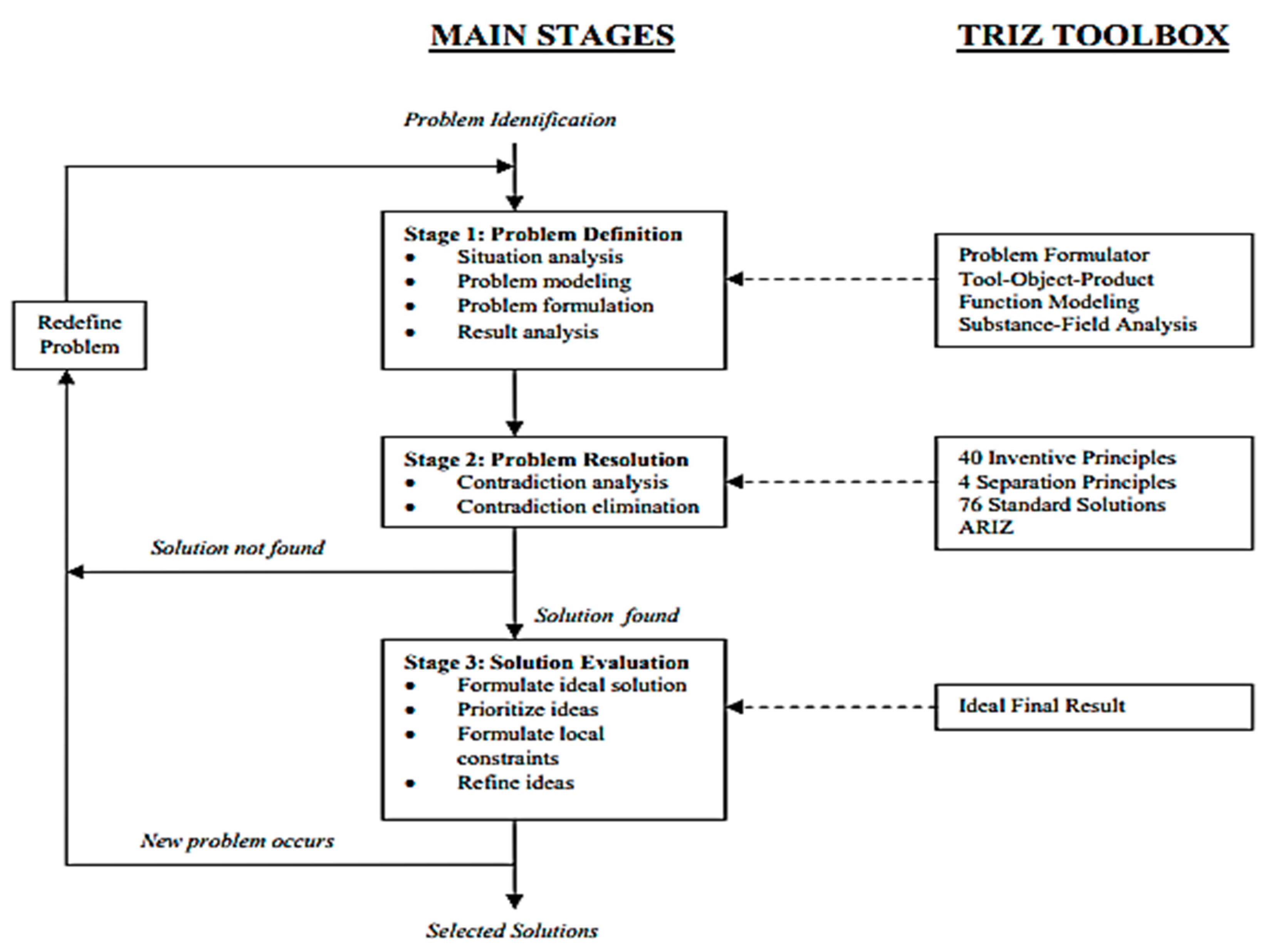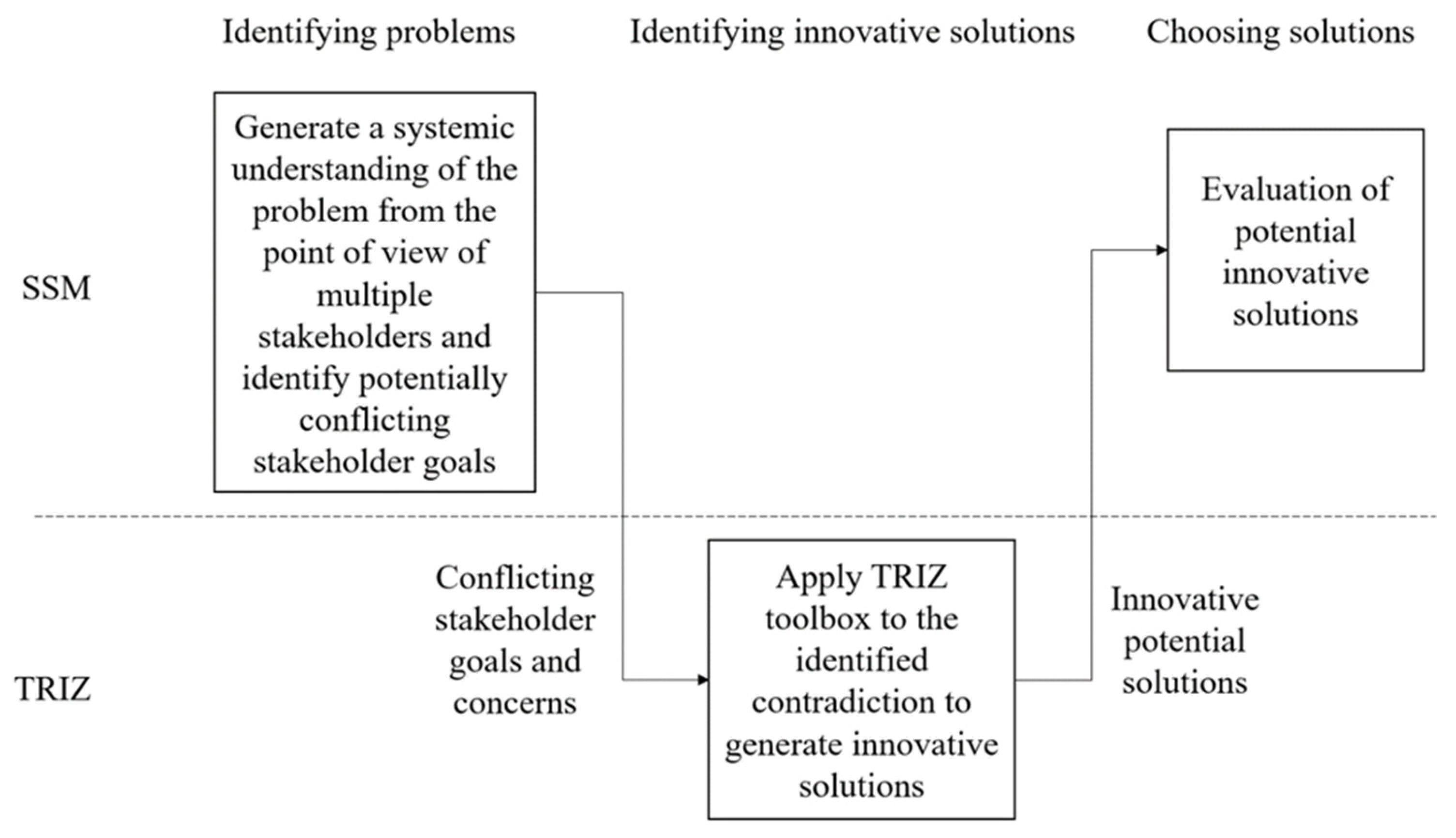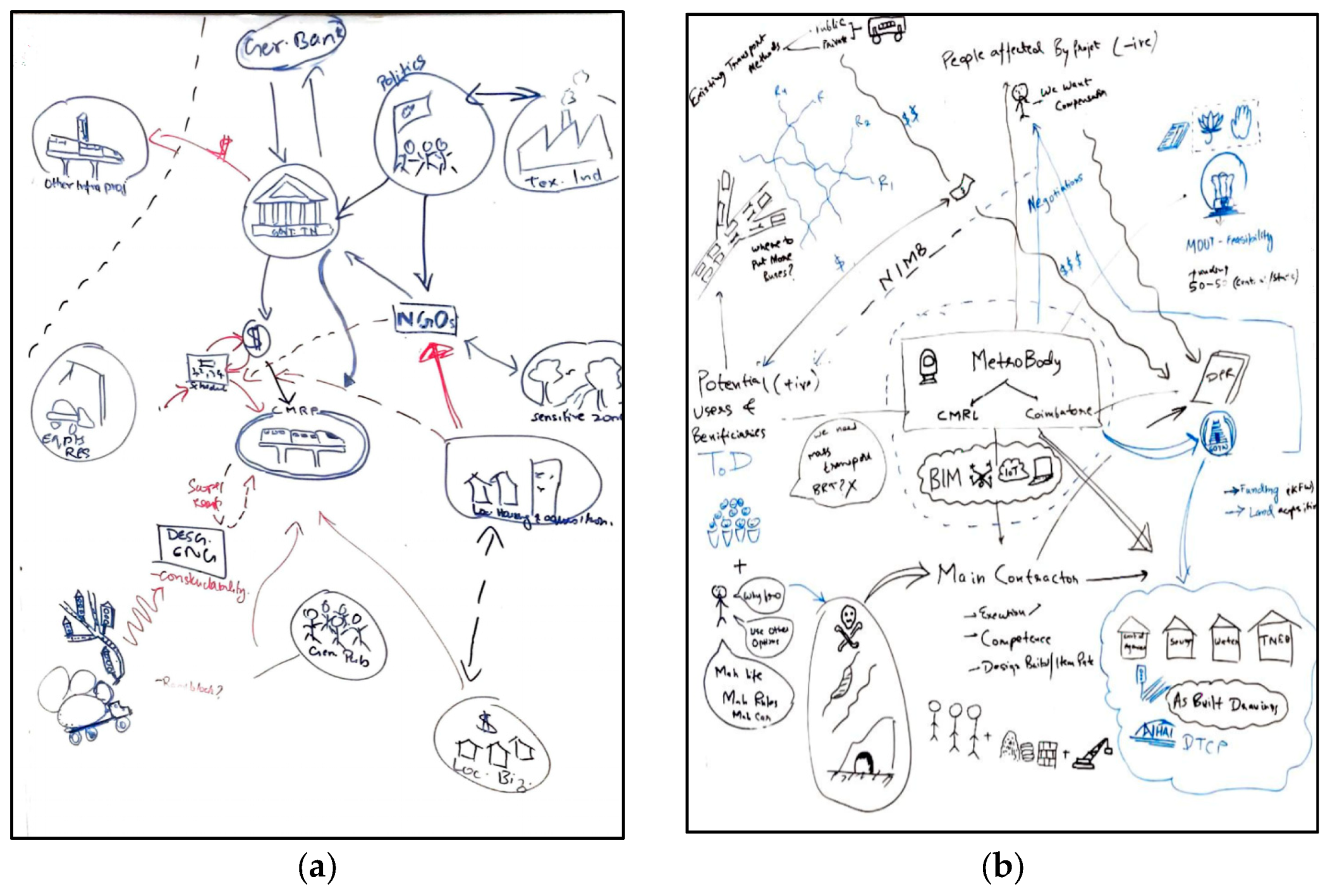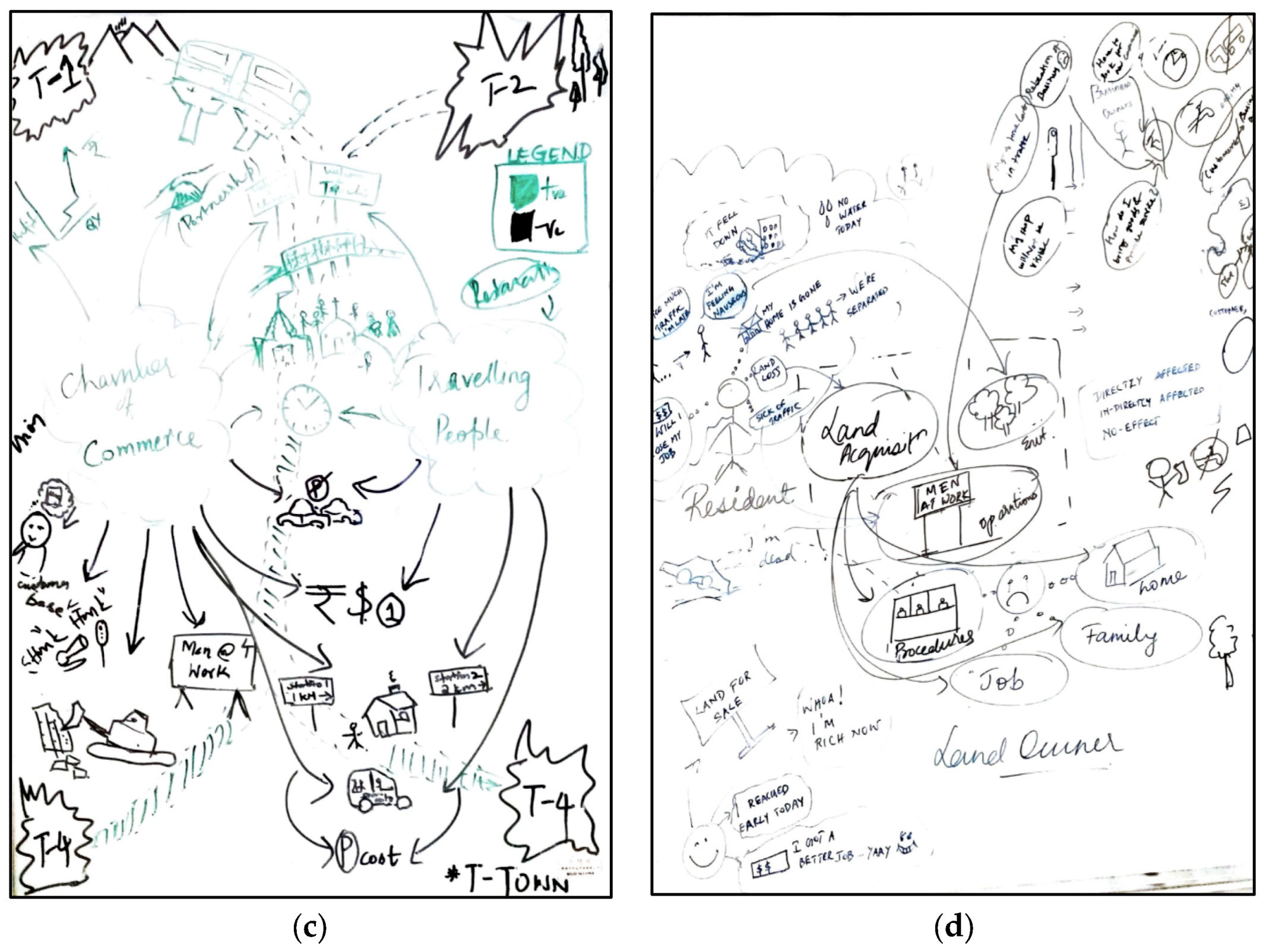Systems Thinking Using SSM and TRIZ for Stakeholder Engagement in Infrastructure Megaprojects
Abstract
:1. Introduction
2. Literature Review
2.1. SSM and Its Use in Stakeholder Engagement in Projects
2.2. TRIZ and Why TRIZ Strengthens SSM
3. Methodology
3.1. Research Setting
3.2. Project Case—Coimbatore Metro Rail Project
3.2.1. Government
3.2.2. Main Contractor
3.2.3. Chamber and Travelling Public
3.2.4. Land Owners and Residents
3.3. Data Collection and Analysis Methodology
4. Results and Discussion
4.1. Holistic Stakeholder Engagement
4.1.1. Holistic View through Rich Picture
4.1.2. Clarity of Thought through CATWOE
4.1.3. Innovative Solutions through TRIZ
4.2. Equipping Future Managers
4.2.1. Empathizing with Stakeholders
4.2.2. Systematic, Critical and Innovative Thinking
4.2.3. Teamwork
5. Conclusions
Author Contributions
Funding
Acknowledgments
Conflicts of Interest
References
- Queiroz, C.A.; Gautam, S. Road Infrastructure and Economic Development: Some Diagnostic Indicators; World Bank Publications: Washington, DC, USA, 1992; Volume 921. [Google Scholar]
- Flyvbjerg, B. What You Should Know about Megaprojects and Why: An overview. Proj. Manag. J. 2014, 45, 6–19. [Google Scholar] [CrossRef]
- Capka, J.R. Megaprojects—They are a Different Breed. Public Roads 2004, 68, 2–9. [Google Scholar]
- Clegg, S.R.; Sankaran, S.; Biesenthal, C.; Pollack, J. Power and sensemaking in megaprojects. In The Oxford Handbook of Megaproject Management; Flyvbjerg, B., Ed.; Oxford University Press: Oxford, UK, 2017; pp. 238–258. [Google Scholar]
- Pitsis, A.; Clegg, S.; Freeder, D.; Sankaran, S.; Burdon, S. Megaprojects redefined–complexity vs cost and social imperatives. Int. J. Manag. Proj. Bus. 2018, 11, 7–34. [Google Scholar] [CrossRef]
- Freeman, E. Strategic Management: A Stakeholder Approach; Pitman: Boston, MA, USA, 1984. [Google Scholar]
- Mitchell, R.K.; Agle, B.R.; Wood, D.J. Toward a theory of stakeholder identification and salience: Defining the principle of who and what really counts. Acad. Manag. Rev. 1997, 22, 853–886. [Google Scholar] [CrossRef]
- Littau, P.; Jujagiri, N.J.; Adlbrecht, G. 25 years of stakeholder theory in project management literature (1984–2009). Proj. Manag. J. 2010, 41, 17–29. [Google Scholar] [CrossRef]
- Lundrigan, C.P.; Gil, N.A.; Puranam, P. The (under) performance of mega-projects: A meta-organizational perspective. In Academy of Management Proceedings; Academy of Management: Briarcliff Manor, NY, USA, 2015; p. 11299. [Google Scholar]
- Miller, R.; Lessard, D.R.; Sakhrani, V. Megaprojects as Games of Innovation. In The Oxford Handbook of Megaproject Management; Flyvbjerg, B., Ed.; Oxford University Press: Oxford, UK, 2017; pp. 217–237. [Google Scholar]
- Orr, R.J.; Scott, W.R. Institutional exceptions on global projects: A process model. J. Int. Bus. Stud. 2008, 39, 562–588. [Google Scholar] [CrossRef]
- Biesenthal, C.; Clegg, S.; Mahalingam, A.; Sankaran, S. Applying institutional theories to managing megaprojects. Int. J. Proj. Manag. 2018, 36, 43–54. [Google Scholar] [CrossRef]
- Mok, K.Y.; Shen, G.Q.; Yang, J. Stakeholder management studies in mega construction projects: A review and future directions. Int. J. Proj. Manag. 2015, 33, 446–457. [Google Scholar] [CrossRef]
- Van-Marrewijk, A.H. Inside Megaprojects: Understanding Cultural Practices in Project Management; Series of Advance Organizational Studies; Liber & Copenhagen Business School Press: Copenhagen, Denmark, 2015. [Google Scholar]
- Li, T.H.; Ng, S.T.; Skitmore, M. Conflict or consensus: An investigation of stakeholder concerns during the participation process of major infrastructure and construction projects in Hong Kong. Habitat Int. 2012, 36, 333–342. [Google Scholar] [CrossRef] [Green Version]
- Black, C.; Akintoye, A.; Fitzgerald, E. An analysis of success factors and benefits of partnering in construction. Int. J. Proj. Manag. 2000, 18, 423–434. [Google Scholar] [CrossRef]
- Vrijhoef, R.; Koskela, L. The four roles of supply chain management in construction. Eur. J. Purch. Supply Manag. 2000, 6, 169–178. [Google Scholar] [CrossRef]
- Rowe, G.; Frewer, L.J. A typology of public engagement mechanisms. Sci. Technol. Hum. Values 2005, 30, 251–290. [Google Scholar] [CrossRef]
- Leung, M.Y.; Yu, J.; Liang, Q. Improving public engagement in construction development projects from a stakeholder’s perspective. J. Constr. Eng. Manag. 2013, 139, 04013019. [Google Scholar] [CrossRef]
- Reed, M.S. Stakeholder participation for environmental management: A literature review. Biol. Conserv. 2008, 141, 2417–2431. [Google Scholar] [CrossRef]
- Sunshine, J.; Tyler, T.R. The role of procedural justice and legitimacy in shaping public support for policing. Law Soc. Rev. 2003, 37, 513–548. [Google Scholar] [CrossRef]
- Rhoads, B.L.; Wilson, D.; Urban, M.; Herricks, E.E. Interaction between scientists and nonscientists in community-based watershed management: Emergence of the concept of stream naturalization. Environ. Manag. 1999, 24, 297–308. [Google Scholar] [CrossRef]
- Eschenbach, R.C.; Eschenbach, T.G. Understanding why stakeholders matter. J. Manag. Eng. 1996, 12, 59–64. [Google Scholar] [CrossRef]
- Kumar, A.; Lodha, D.; Mahalingam, A.; Prasad, V.; Sahasranaman, A. Using ‘design thinking’ to enhance urban re-development: A case study from India. Eng. Proj. Org. J. 2016, 6, 155–165. [Google Scholar] [CrossRef]
- Winch, G. Megaproject Stakeholder Management. In The Oxford Handbook of Megaproject Management; Flyvbjerg, B., Ed.; Oxford University Press: Oxford, UK, 2017; pp. 339–361. [Google Scholar]
- Ninan, J.; Mahalingam, A.; Clegg, S. External Stakeholder Management Strategies and Resources in Megaprojects: An Organizational Power Perspective. Proj. Manag. J. 2019. [Google Scholar] [CrossRef]
- Takayanagi, N.; Mizutani, Y.; Loucks, D.P. Stakeholder consensus building in multiobjective environments. J. Water Res. Plan. Man. 2010, 137, 293–303. [Google Scholar] [CrossRef]
- Henisz, W.J. The dynamic capability of corporate diplomacy. Glob. Strateg. J. 2016, 6, 183–196. [Google Scholar] [CrossRef]
- Moura, H.M.; Teixeira, J.C. Managing stakeholders conflicts. In Construction Stakeholder Management; Chinyio, E., Ed.; Blackwell: Oxford, UK, 2010; pp. 286–316. [Google Scholar]
- McCoy, M.L.; Scully, P.L. Deliberative dialogue to expand civic engagement: What kind of talk does democracy need? Natl. Civ. Rev. 2002, 91, 117–135. [Google Scholar] [CrossRef]
- Aaltonen, K.; Sivonen, R. Response strategies to stakeholder pressures in global projects. Int. J. Proj. Manag. 2009, 27, 131–141. [Google Scholar] [CrossRef]
- Ninan, J.; Mahalingam, A. Stakeholder Management Strategies in Infrastructure Megaprojects—A Dimensions of Power Perspective. In Proceedings of the Engineering Project Organization Conference (EPOC), South Lake Tahoe, CA, USA, 5–7 June 2017. [Google Scholar]
- Ng, A.; Loosemore, M. Risk allocation in the private provision of public infrastructure. Int. J. Proj. Manag. 2007, 25, 66–76. [Google Scholar] [CrossRef]
- Ninan, J.; Clegg, S.R.; Mahalingam, A. Branding and Governmentality for Infrastructure Megaprojects: The role of Social Media. Int. J. Proj. Manag. 2019, 37, 59–72. [Google Scholar] [CrossRef]
- Vuorinen, L.; Martinsuo, M. Value-oriented stakeholder influence on infrastructure projects. Int. J. Proj. Manag. 2019, 37, 750–766. [Google Scholar] [CrossRef]
- Royer, P.S. Risk management: The undiscovered dimension of project management. Proj. Manag. J. 2000, 31, 6–13. [Google Scholar] [CrossRef]
- Merrow, E.W. Oil and gas industry megaprojects: Our recent track record. Oil Gas Facil. 2012, 1, 38–42. [Google Scholar] [CrossRef]
- Checkland, P. Towards a systems-based methodology for real-world problem-solving. In Systems Behaviour; Beishon, J., Peters, G., Eds.; Harper and Row: London, UK, 1976; pp. 51–77. [Google Scholar]
- Altshuller, G.S. Creativity as an Exact Science; Gordon & Breach Science Publishers: New York, NY, USA, 1984. [Google Scholar]
- Muzio, E.; Fisher, D.J.; Thomas, E.R.; Peters, V. Soft Skills Quantification (SSQ) Foi Project Manager Competencies. Proj. Manag. J. 2007, 38, 30–38. [Google Scholar] [CrossRef]
- Jepsen, A.L.; Eskerod, P. Stakeholder analysis in projects: Challenges in using current guidelines in the real world. Int. J. Proj. Manag. 2009, 27, 335–343. [Google Scholar] [CrossRef] [Green Version]
- Hindle, G.A. Case Article—Teaching Soft Systems Methodology and a Blueprint for a Module. Inf. Trans. Educ. 2011, 12, 31–40. [Google Scholar] [CrossRef]
- Rosenhead, J.; Mingers, J. Rational Analysis for a Problematic World Revisited: Problem Structuring Methods for Complexity, Uncertainty, and Conflict, 2nd ed.; Wiley: West Sussex, UK, 2001. [Google Scholar]
- Mingers, J.; Rosenhead, J. Problem structuring methods in action. Eur. J. Oper. Res. 2004, 152, 530–554. [Google Scholar] [CrossRef]
- Jackson, M.; Keys, P. Towards a System of Systems Methodology. J. Oper. Res. Soc. 1984, 35, 473–486. [Google Scholar] [CrossRef]
- Ackoff, R. The Systems Revolution. Long Range Plann. 1974, 7, 2–20. [Google Scholar] [CrossRef]
- Jackson, M.C. Systems Thinking: Creative Holism for Managers; John Wiley & Sons, Ltd.: West Sussex, UK, 2003. [Google Scholar]
- Checkland, P.B. Systems Thinking, Systems Practice; Wiley: Chichester, UK, 1981. [Google Scholar]
- Checkland, P.; Scholes, J. Soft Systems Methodology in Action; Wiley: West Sussex, UK, 1990. [Google Scholar]
- Checkland, P.; Poulter, J. Learning for Action: A Short Definitive Account of Soft Systems Methodology and Its Use for Practitioners, Teachers, and Students; Wiley: West Sussex, UK, 2006. [Google Scholar]
- Teles, M.D.; Friere de Souza, J. Environmental Management and Business Strategy: Structuring the decision-making support in a public transport company. Transp. Res. Proc. 2014, 3, 155–164. [Google Scholar] [CrossRef]
- Winter, M. Problem structuring in project management: An application of soft systems methodology. J. Oper. Res. Soc. 2006, 57, 802–812. [Google Scholar] [CrossRef]
- Jackson, M. Systems Approaches to Management; Kluwer Academic/Plenum: New York, NY, USA, 2000. [Google Scholar]
- Mingers, J. Taylor, S. The use of soft systems methodology in practice. J. Oper. Res. Soc. 1992, 43, 321–332. [Google Scholar] [CrossRef]
- Domb, E. QFD and TIPS/TRIZ. Triz J. 1998. Available online: http://www.trizjournal.com/archives/1998/06/c/ index.htm (accessed on 20 June 2019).
- Chai, K.H.; Zhang, J.; Tan, K.C. A TRIZ-Based Method for New Service Design. J. Serv. Res. 2005, 8, 48–66. [Google Scholar] [CrossRef] [Green Version]
- Phillips, I.; Kenley, C.R. An SSM-TRIZ Methodology for Business Problem Structuring. In Proceedings of the Annual INCOSE International Symposium, Orlando, FL, USA, 20–25 July 2019. [Google Scholar]
- Ilevbare, I.M.; Probert, D.; Phaal, R. A review of TRIZ, and its benefits and challenges in practice. Technovation 2013, 33, 30–37. [Google Scholar] [CrossRef]
- Bonnema, M.G. Insight, Innovation and the Big Picture in Systems Design. Syst. Eng. 2011, 14, 223–238. [Google Scholar] [CrossRef]
- Bryan, C.J.; Dagli, C. A Conflict Resolution Approach to Capturing System Architecting Lessons Learned; INCOSE: Rochester, NY, USA, 2005. [Google Scholar]
- Blackburn, T.D.; Mazzuchi, T.A.; Sarkani, S. Using a TRIZ Framework for Systems Engineering Trade Studies. Syst. Eng. 2015, 15, 355–367. [Google Scholar] [CrossRef]
- Ishida, A. Using TRIZ to Create Innovative Business Models and Product. Triz J. 2003. Available online: https://triz-journal.com/using-triz-create-innovative-business-models-products/ (accessed on 15 May 2019).
- Lepeshev, A.A.; Podlesnyi, S.A.; Pogrebnaya, T.V.; Kozlov, A.V.; Sidorkina, O.V. TRIZ-based Engineering Education for Sustainable Development. In Proceedings of the International Conference on Interactive Collaborative Learning (ICL), Kazan, Russia, 25–27 September 2013; IEEE: Kazan, Russia, 2013. [Google Scholar]
- Khomenko, N.; Ashtiani, M. Classical TRIZ and OTSM as a scientific theoretical background for non-typical problem-solving instruments. In ETRIA TRIZ Future; ETRIA: Frankfurt, Germany, 2007; pp. 6–8. [Google Scholar]
- Smith, J.; Love, P.E. Stakeholder management during project inception: Strategic needs analysis. J. Archit. Eng. 2004, 10, 22–33. [Google Scholar] [CrossRef]
- Yang, R.J. An investigation of stakeholder analysis in urban development projects: Empirical or rationalistic perspectives. Int. J. Proj. Manag. 2014, 32, 838–849. [Google Scholar] [CrossRef]
- El-Gohary, N.M.; Osman, H.; El-Diraby, T.E. Stakeholder management for public private partnerships. Int. J. Proj. Manag. 2006, 24, 595–604. [Google Scholar] [CrossRef]
- Kilmann, R.H.; Thomas, K.W. Interpersonal conflict-handling behavior as reflections of Jungian personality dimensions. Psychol. Rep. 1975, 37, 971–980. [Google Scholar] [CrossRef]
- Dorst, K. Frame creation and design in the expanded field. She Ji J. Des. Econ. Innov. 2015, 1, 22–33. [Google Scholar] [CrossRef]
- Sheffield, S.; Sankaran, S.; Haslett, T. Teaching systems thinking to tame complexity in project management. Horizon 2012, 20, 126–136. [Google Scholar] [CrossRef]
- Hindle, G.A. Teaching soft systems methodology and a blueprint for the future. Inf. Trans. Educ. 1995, 12, 31–40. [Google Scholar] [CrossRef]
- Rucker, D.G. Crowdsourcing Wisdom: A Guide to Doing Public Meetings that Actually Make Your Community Better; Wise Fool Press: Cincinnati, OH, USA, 2015. [Google Scholar]
- Sharma, N.; Dhyani, R.; Gangopadhyay, S. Critical issues related to metro rail projects in India. J. Infrastruct. Dev. 2013, 5, 67–86. [Google Scholar] [CrossRef]
- Ashokan, M.S. Karmayogi: A Biography of E. Sreedharan; Penguin: London, UK, 2015. [Google Scholar]
- Söderlund, J.; Sankaran, S.; Biesenthal, C. The Past and Present of Megaprojects. Proj. Manag. J. 2017, 48, 5–16. [Google Scholar] [CrossRef]
- Park, H.; Kim, K.; Kim, Y.W.; Kim, H. Stakeholder management in long-term complex megaconstruction projects: The Saemangeum Project. J. Manag. Eng. 2017, 33, 05017002. [Google Scholar] [CrossRef]
- Skipper, C.; Greenlee, L.; Finch, J.; Marley, K. Emotional Intelligence and Undergraduate Engineering Students. Eng. Proj. Org. J. 2017, 7, 1–13. [Google Scholar]




| Methods | Strengths | Weaknesses |
|---|---|---|
| SSM | (a) Provides a holistic understanding of the problem from a systemic perspective (b) Integrates various perspectives of different actors involved in resolving the problem | (a) Does not provide firm guidelines toward uncovering why problems occur (b) Does not offer a mechanism/tool for resolving contradictions at the heart of conflicting interests (c) Ideality thinking is not part of the toolbox (d) Inhibits hard systems thinking approaches in most cases unless worldviews have been collapsed into one |
| TRIZ | (a) Breaks problems down into discovering inherent contradictions that provide clues for the solutions (b) Embraces the concept of ideality (c) Possesses contradiction resolution techniques (40 inventive principles, ARIZ, separation techniques, etc.) (d) Encourages the further pursuit of hard thinking approaches for definitive solution implementations | (a) Tools for problem definition do not encompass a pluralistic appreciation of the issue at hand (b) The resolution process is based on the perspective of the problem solver instead of embracing the perspectives of other principal actors |
| Time | Topic/Activity |
|---|---|
| 09:00 to 09:15 | Participants arrive and set up |
| 09.15 to 09:30 | Welcome and Introductions |
| 09:30 to 10:15 | Introduce Systems Thinking, SSM and the case |
| 10:15 to 10:30 | Introduce Activity 1—Drawing Rich Pictures |
| 10.30 to 10:45 | Coffee Break |
| 10.45 to 11:45 | Activity 1—Draw Rich Pictures |
| 11.45 to 12:15 | Walk About to Discuss Rich Pictures |
| 12.15 to 13:15 | Lunch |
| 13:15 to 13:45 | Introduce CATWOE and Root Definition |
| 13:45 to 14:15 | Activity 2—CATWOE and Root Definition |
| 14:15 to 14:30 | Coffee Break |
| 14:30 to 15:00 | Introduce TRIZ |
| 15:00 to 15:30 | Activity 3—Dealing with contradictions |
| 15:30 to 15:45 | Voting on innovations |
| 15:45 to 16:30 | Discussions, Reflections, Feedback and Close |
| Stakeholder | Root Definition |
|---|---|
| Government | The Coimbatore metro project aims to give a fast, convenient and affordable transportation to the public using modern technologies, better stakeholder management, sustainable solutions and appropriately resolving the grievances of the public which will help in efficient multi-modal transportation provided by the state government in consideration with the environment. |
| Main Contractor | To complete within specified cost, time and quality, with zero accidents to maximize the value to the government within the particular environmental constraints. |
| Chamber and Traveling Public | To develop an affordable metro project within the stipulated time with minimal displacement of existing systems. |
| Owners and residents | To have a metro rail project to be built in such a way that there are minimal negative effects on the lives of the residents, landowners, and business owners, with speedy completion of the project and considering traffic and pollution levels. For whatever effects that are created, these stakeholders should be compensated to their satisfaction. |
© 2019 by the authors. Licensee MDPI, Basel, Switzerland. This article is an open access article distributed under the terms and conditions of the Creative Commons Attribution (CC BY) license (http://creativecommons.org/licenses/by/4.0/).
Share and Cite
Ninan, J.; Phillips, I.; Sankaran, S.; Natarajan, S. Systems Thinking Using SSM and TRIZ for Stakeholder Engagement in Infrastructure Megaprojects. Systems 2019, 7, 48. https://0-doi-org.brum.beds.ac.uk/10.3390/systems7040048
Ninan J, Phillips I, Sankaran S, Natarajan S. Systems Thinking Using SSM and TRIZ for Stakeholder Engagement in Infrastructure Megaprojects. Systems. 2019; 7(4):48. https://0-doi-org.brum.beds.ac.uk/10.3390/systems7040048
Chicago/Turabian StyleNinan, Johan, Ibukun Phillips, Shankar Sankaran, and Swaminathan Natarajan. 2019. "Systems Thinking Using SSM and TRIZ for Stakeholder Engagement in Infrastructure Megaprojects" Systems 7, no. 4: 48. https://0-doi-org.brum.beds.ac.uk/10.3390/systems7040048





